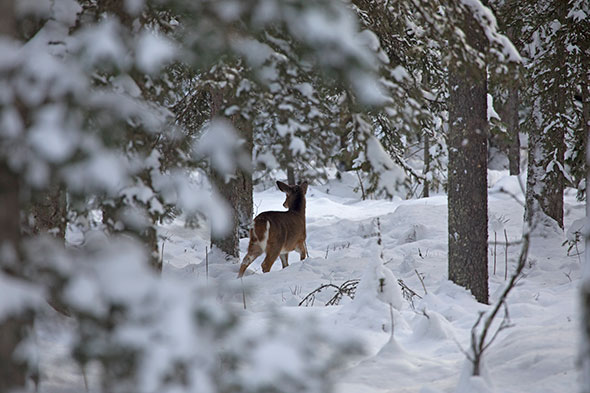Last updated: December 31, 2020
Lesson Plan
Snug in the Snow

- Grade Level:
- Upper Elementary: Third Grade through Fifth Grade
- Subject:
- Science
- Lesson Duration:
- 60 Minutes
- Additional Standards:
- 3-LS4-3 Construct an argument with evidence that in a habitat some
organisms can survive well, some survive less well, and some cannot
survive at all.
Essential Question
How does snow help animals survive the winter?
Objective
Students will understand how understand how snow can benefit animals throughout the winter.
Background
Many small animals rely upon a blanket of snow for winter survival. Mice, voles and shrews live in this subnivean world by tunneling through snow and feeding on seeds of plants, bark from trees and shrubs and even storing small amounts of food in it. These small animals’ tracks are often seen across the surface of snow which makes them vulnerable to predators such as ermine, hawks and owls. Many of the “mouse holes” seen on the snow surface are actually vent holes to allow carbon dioxide from decaying plants to escape so these small animals don’t suffocate. Snowshoe hares and grouse take advantage of the snow by snuggling into it for protection from cold and winds. Snow also allows the hares to reach higher up on trees and shrubs to feed.
Preparation
- Vocabulary and definitions
- Shoebox - one for each group
- Cotton
- Paper, or styrofoam pieces
- Scissors
- Chalk or tempera paint and brush
- Twigs, dried weeds, evergreen sprigs, cones
- Clay
Procedure
- Review the following vocabulary words with your class: Subnivean, Supranivean, Predator, Prey, Insulation.
- Review the material provided in this teacher’s guide and discuss animal adaptations for living under the snow with the class.
- Divide into groups. Have students lay a shoebox on its side and whiten the inside with chalk or tempera paint.
- Cut away the roof and replace it with a piece of white paper or cotton cut to size (styrofoam could also be used). Allow paper or cotton to extend about 1/4 to 1/2 inch beyond the surface it is replacing. Hold it in place with toothpicks, tape, or glue.
- Decorate the top with twigs, dried weeds, bits of evergreen.
- Make animals out of clay or play-dough and place them where they belong, either above or below the snow.
Variations and Extensions:
Have entire class produce a larger diorama over a period of days in a large cardboard box.
Vocabulary
Subnivean: from the latin words for "under snow". The subnivean zone is the area between the surface of the ground and the bottom of the snowpack.
Supranivean: from latin, meaning above, or on the surface of snow.
Predator: an animal that hunts, kills, and eats other animals
Prey: an animal that is hunted, killed and eaten by other animals.
Insulation: the act of covering something to stop heat, or other types of energy, from escaping or entering.
Assessment Materials
Ask the students to pretend they are one of the characters in their diorama and have them write a story about life in a subnivean world.
Is it Dark/Light? Cold/Warm? Quiet/Noisy? Cozy/Lonely?
